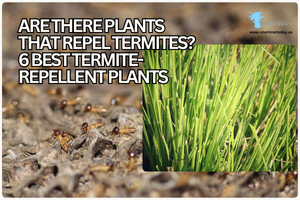Termites are among the most destructive pests, causing billions of dollars in property damage each year. While chemical treatments are effective, many homeowners prefer natural solutions to keep these pests at bay. Surprisingly, certain plants can help deter termites due to their natural compounds and strong scents.
In this article, we’ll explore six of the best termite-repellent plants that can protect your home and garden while adding beauty and functionality to your landscape.
1. Vetiver Grass (Chrysopogon zizanioides)
Why It Works: Vetiver grass contains compounds like nootkatone and vetiverol, which repel termites and other pests. Its deep root system also helps improve soil health.
How to Use: Plant around the perimeter of your home or garden to create a natural barrier.
2. Marigolds (Tagetes spp.)
Why It Works: Marigolds release alpha-terthienyl, a natural chemical that repels termites, nematodes, and other soil-dwelling pests.
How to Use: Plant near foundations, garden beds, or areas prone to termite activity.
3. Mint (Mentha spp.)
Why It Works: The strong scent of peppermint and spearmint is unpleasant to termites. Mint oil is also a known natural insect repellent.
How to Use: Grow in pots near entry points or use crushed leaves as a natural deterrent.
4. Garlic (Allium sativum)
Why It Works: Garlic contains allicin, a compound that repels termites and other insects.
How to Use: Plant around the garden or use garlic spray on wooden structures.
5. Catnip (Nepeta cataria)
Why It Works: Catnip contains nepetalactone, which repels termites, ants, and cockroaches.
How to Use: Plant near wooden structures or use dried leaves as a barrier.
6. Lemongrass (Cymbopogon citratus)
Why It Works: Lemongrass contains citronella oil, which has insect-repellent properties.
How to Use: Plant near foundations or use essential oil as a natural spray.
How to Use Termite-Repellent Plants Effectively
- Plant a Protective Barrier – Place these plants around your home’s foundation, garden beds, and wooden structures.
- Use Essential Oils – Extracts from these plants can be mixed with water and sprayed on vulnerable areas.
- Combine with Other Methods – For severe infestations, combine plant barriers with physical or chemical treatments.
FAQ Section
1. Do termite-repellent plants completely eliminate termites?
While these plants can deter termites, they may not eliminate an existing infestation. For severe problems, professional pest control is recommended.
2. Can I use essential oils from these plants for termite control?
Yes! Oils like neem, vetiver, and peppermint can be diluted and sprayed on wood or soil to repel termites.
3. Are these plants safe for pets?
Most are safe, but some (like pennyroyal and certain mints) can be toxic to pets in large quantities. Always research before planting.
4. How quickly do these plants work against termites?
They work best as a preventative measure rather than an instant solution. Regular planting and maintenance enhance their effectiveness.
5. Can I grow these plants indoors for termite prevention?
Yes! Potted mint, lemongrass, and garlic can be grown indoors near wooden furniture or entry points.
6. Do these plants repel other pests?
Yes! Many also deter ants, mosquitoes, and cockroaches, making them great for overall pest control.
Conclusion
Using termite-repellent plants is an eco-friendly way to protect your home from these destructive pests. While they may not replace professional treatments for severe infestations, they serve as an excellent preventative measure. By incorporating these six plants into your garden, you can create a natural defense system while enhancing your landscape’s beauty.




